Related Research Articles

The following is a timeline of galaxies, clusters of galaxies, and large-scale structure of the universe.

A galaxy cluster, or a cluster of galaxies, is a structure that consists of anywhere from hundreds to thousands of galaxies that are bound together by gravity, with typical masses ranging from 1014 to 1015 solar masses. They are the second-largest known gravitationally bound structures in the universe after some superclusters (of which only one, the Shapley Supercluster, is known to be bound). They were believed to be the largest known structures in the universe until the 1980s, when superclusters were discovered. One of the key features of clusters is the intracluster medium (ICM). The ICM consists of heated gas between the galaxies and has a peak temperature between 2–15 keV that is dependent on the total mass of the cluster. Galaxy clusters should not be confused with galactic clusters (also known as open clusters), which are star clusters within galaxies, or with globular clusters, which typically orbit galaxies. Small aggregates of galaxies are referred to as galaxy groups rather than clusters of galaxies. The galaxy groups and clusters can themselves cluster together to form superclusters.

XMM-Newton, also known as the High Throughput X-ray Spectroscopy Mission and the X-ray Multi-Mirror Mission, is an X-ray space observatory launched by the European Space Agency in December 1999 on an Ariane 5 rocket. It is the second cornerstone mission of ESA's Horizon 2000 programme. Named after physicist and astronomer Sir Isaac Newton, the spacecraft is tasked with investigating interstellar X-ray sources, performing narrow- and broad-range spectroscopy, and performing the first simultaneous imaging of objects in both X-ray and optical wavelengths.

Arp 220 is the result of a collision between two galaxies which are now in the process of merging. It is the 220th object in Halton Arp's Atlas of Peculiar Galaxies.
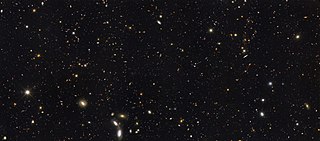
The Great Observatories Origins Deep Survey, or GOODS, is an astronomical survey combining deep observations from three of NASA's Great Observatories: the Hubble Space Telescope, the Spitzer Space Telescope, and the Chandra X-ray Observatory, along with data from other space-based telescopes, such as XMM Newton, and some of the world's most powerful ground-based telescopes.
2XMM J083026+524133 is a very large galaxy cluster that lies 7.7 billion light-years away. It was discovered by chance by ESA's XMM Newton and the Large Binocular Telescope (LBT) in Arizona in 2008 while it was looking at the quasar APM 08279+5255.

The 215th meeting of the American Astronomical Society (AAS) took place in Washington, D.C., Jan. 3 to Jan. 7, 2010. It is one of the largest astronomy meetings ever to take place as 3,500 astronomers and researchers were expected to attend and give more than 2,200 scientific presentations. The meeting was actually billed as the "largest Astronomy meeting in the universe". An array of discoveries were announced, along with new views of the universe that we inhabit; such as quiet planets like Earth - where life could develop are probably plentiful, even though an abundance of cosmic hurdles exist - such as experienced by our own planet in the past.
MACS0647-JD is a galaxy with a redshift of about z = 10.7, equivalent to a light travel distance of 13.26 billion light-years. If the distance estimate is correct, it formed about 427 million years after the Big Bang.
SXDF-NB1006-2 is a distant galaxy located in the Cetus constellation, with a spectroscopic redshift of z = 7.213 or 12.91 billion light-years away. It was discovered by the Subaru XMM-Newton Deep Survey Field. The galaxy was claimed to be the most distant galaxy at announcement in June 2012, as the more distant claimants were not confirmed spectroscopically at the time. It exceeded the previous confirmed distance holder, GN-108036, also discovered by the Subaru. Oxygen emission lines have been detected in its spectrum.
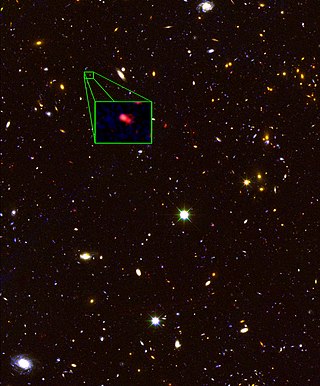
z8_GND_5296 is a dwarf galaxy discovered in October 2013 which has the highest redshift that has been confirmed through the Lyman-alpha emission line of hydrogen, placing it among the oldest and most distant known galaxies at approximately 13.1 billion light-years (4.0 Gpc) from Earth. It is "seen as it was at a time just 700 million years after the Big Bang [...] when the universe was only about 5 percent of its current age of 13.8 billion years". The galaxy is at a redshift of 7.51, and it is a neighbour to what was announced then as the second-most distant galaxy with a redshift of 7.2. The galaxy in its observable timeframe was producing stars at a phenomenal rate, equivalent in mass to about 330 Suns per year.
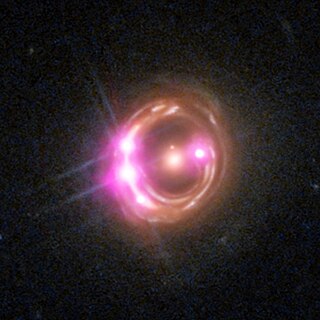
RX J1131-1231 is a distant, supermassive-black-hole-containing quasar located about 6 billion light years from Earth in the constellation Crater.

The galaxy cluster IRC 0218 hosts the most distant strong gravitational lensing galaxy currently known at a redshift of z = 1.62. The lens is one of the two brightest cluster galaxies and is lensing a background star-forming galaxy at a redshift of z = 2.26 into a bright arc and a faint counterimage. The lens was discovered through a combination of Hubble Space Telescope and Keck telescope imaging and spectroscopy. The discovery and subsequent analysis of the lens was published in the Astrophysical Journal Letters on June 23, 2014 by an international team of astronomers led by Dr. Kim-Vy Tran from Texas A&M University in College Station, Texas and team members Dr. Kenneth Wong and Dr. Sherry Suyu from the Academia Sinica Institute of Astronomy and Astrophysics in Taipei, Taiwan.

The XDCPJ0044.0-2033 (Gioello) galaxy cluster at redshift z=1.579 was discovered in the archive of the XMM-Newton mission, as part of the XMM-Newton Distant Cluster Project (XDCP) and first published by Santos et al. 2011. Gioiello is the most distant massive galaxy cluster that has been found and studied today. This massive galaxy cluster contains 400 trillion times the mass of the Sun and is located 9.6 billion light years away from Earth. The name Gioiello, meaning "jewel" in Italian, was given to this massive galaxy cluster because an image of the cluster contains many beautiful pink, purple, and red sparkling colors from the hot X-ray–emitting gas and other star-forming galaxies within the cluster.
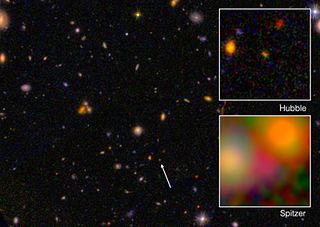
EGSY8p7 (EGSY-2008532660) is a distant galaxy in the constellation of Boötes, with a spectroscopic redshift of z = 8.68, a light travel distance of 13.2 billion light-years from Earth. Therefore, at an age of 13.2 billion years, it is observed as it existed 570 million years after the Big Bang, which occurred 13.8 billion years ago, using the W. M. Keck Observatory. In July 2015, EGSY8p7 was announced as the oldest and most-distant known object, surpassing the previous record holder, EGS-zs8-1, which was determined in May 2015 as the oldest and most distant object. In March 2016, Pascal Oesch, one of the discoverers of EGSY8p7, announced the discovery of GN-z11, an older and more distant galaxy.

IDCS J1426.5+3508 is an extremely massive young galaxy cluster. It is the most massive galaxy cluster detected at such an early age.
MACS 1423-z7p64 is a galaxy listed in the MAssive Cluster Survey (MACS), and announced on 10 April 2017 in the journal Nature Astronomy, as being the most distant source of reionization known at this time, with a redshift z = 7.640 ± 0.001.
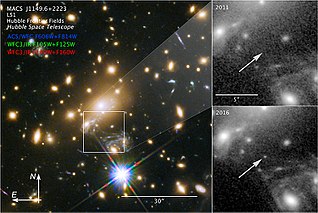
MACS J1149 Lensed Star 1, also known as Icarus, is a blue supergiant star observed through a gravitational lens. It is the seventh most distant individual star to have been detected so far, at approximately 14 billion light-years from Earth. Light from the star was emitted 4.4 billion years after the Big Bang. According to co-discoverer Patrick Kelly, the star is at least a hundred times more distant than the next-farthest non-supernova star observed, SDSS J1229+1122, and is the first magnified individual star seen.

The Hyperion proto-supercluster is the largest and earliest known proto-supercluster, 5,000 times the mass of the Milky Way and seen at 20% of the current age of the universe. It was discovered in 2018 by analysing the redshifts of 10,000 objects observed with the Very Large Telescope in Chile.

HD1 is a proposed high-redshift galaxy, which is considered to be one of the earliest and most distant known galaxies yet identified in the observable universe. The galaxy, with an estimated redshift of approximately z = 13.27, is seen as it was about 324 million years after the Big Bang, which was according to scientists around 13.787 billion years ago. It has a light-travel distance of 13.463 billion light-years from Earth, and, due to the expansion of the universe, a present proper distance of 33.288 billion light-years.
References
- Most Distant Galaxy Cluster Found 10 Billion light-years Away XMM Cluster Survey (XCS)
- The XMM Cluster Survey: A Massive Galaxy Cluster at z=1.45 S. A. Stanford (arXiv preprint) Sun, 4 Jun 2006 16:23:55 GMT
- 1 2 http://www.physorg.com/news68820846.html Massive galaxy cluster found 10 billion light years away June 6th, 2006, Space & Earth magazine
- ↑ "Grad Student Helps Discover Massive Galaxy Cluster 10 Billion Light Years Away". Cmu.edu. 2006-06-15. Retrieved 2022-05-25.
- ↑ The Journal (Newcastle, England) June 10, 2006 [ dead link ]
- ↑ "Galaxy Cluster Most Distant from Earth Found, June 5, 2006, UC DAVIS
- ↑ "Most Distant Galaxy Cluster Discovered". 7 June 2006.